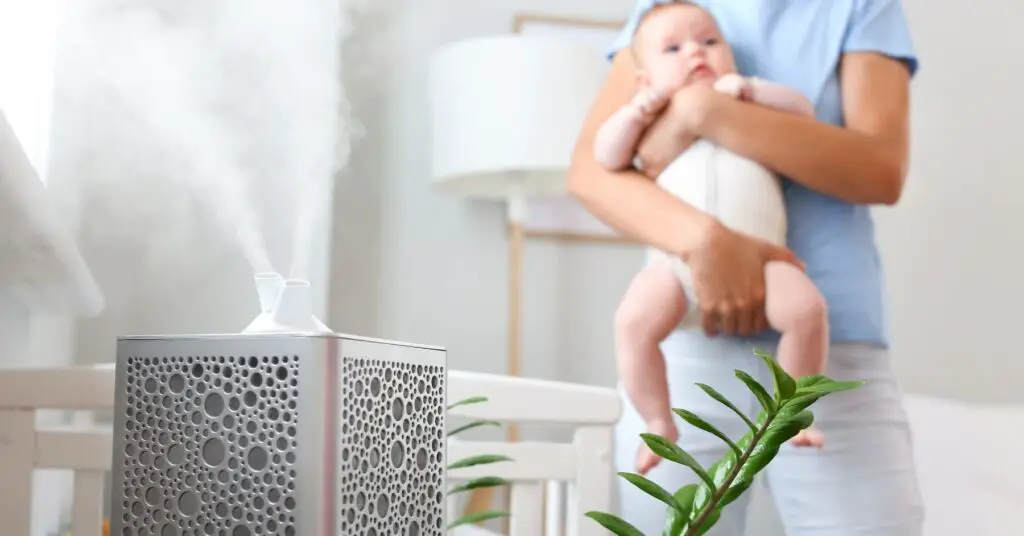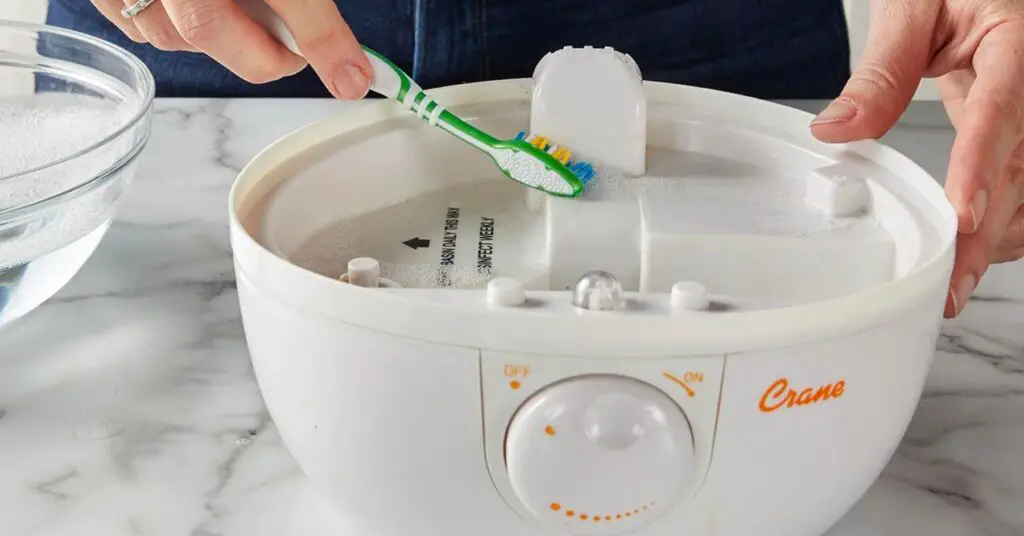
Soothing Your Little One: Putting Vicks in Humidifier for Baby
The “Do’s and Don’ts” of Putting Vicks in Humidifier for Your Baby
| Do’s | Don’ts |
| Use Cold Mist Humidifier | Add Vicks directly to water |
| Clean Daily | Run for more than 10 hours |
| Monitor for Mold |
Is It Okay, or Am I Just Being a Fussy Mama?
After raising five kiddos, a touch of paranoia comes with the territory. And when it comes to putting Vicks in a humidifier for a baby, well, I’ve been there, done that, and got the T-shirt. But, hey, we’re talking about our precious little bundles of joy, and there’s no room for guesswork here.
The direct answer to your concern? Yes, it’s absolutely okay to use a Vicks vaporizer for your baby. Whew! Now, grab a cuppa, and let’s dive into the nitty-gritty of why and how to go about it.
Why Putting Vicks in a Humidifier for Baby Can Be Your Little Hero
Once, when my third child was battling a cold, I was as frantic as a cat on a hot tin roof. A neighbor advised me to try putting Vicks in a humidifier, and let’s just say it was a great decision.
The Goodness of Vicks
I compare Vicks Vaporub to chicken soup for the soul (but for your baby’s stuffy nose). It contains menthol, camphor, and eucalyptus oil—nature’s own little miracle workers. These ingredients not only clear up congestion but also put up a good fight against those nasty viruses and bacteria.
Gentle Vapor to the Rescue
Now, smearing Vicks Vaporub directly onto a (less than 2yo, according to experts!) baby’s skin might be overkill. But by putting Vicks in a humidifier, you’re creating a gentle vapor that’ll clear your baby’s airways without causing a ruckus. It’s like a soft lullaby for their tiny nostrils. Just use about a teaspoon per gallon of water, and you’ll be in the clear.
*They have Vicks® BabyRub for 3m-2yo
How to Use Vicks in a Humidifier for Your Baby Correctly

Now, here’s where it gets practical. Putting Vicks in a humidifier for a baby isn’t rocket science, but you’ll want to get it just right.
- Find the Right Spot: Place the humidifier in the room where your baby sleeps but out of reach of curious little fingers.
- Measure the Vicks: Remember the golden ratio? A teaspoon of Vicks per gallon of water. No more, no less.
- Use a Cold Mist Humidifier: Warm mist is a no-go for newborns, so stick to a cold mist humidifier.
- Clean Daily: You wouldn’t feed your baby with dirty utensils, so don’t let them breathe dirty air. Clean that humidifier daily!
- Don’t Overdo It: Keep the humidifier running for no more than 8 to 10 hours a day. Too much moisture can turn into a real party pooper.
The Unsung Heroes: Benefits of a Humidifier in a Baby’s Room
Now, I’ve waxed poetic about putting Vicks in a humidifier for a baby, but let’s not overlook the humidifier itself.
Breathing Easy
- Moist Air for Little Noses: Keeps those tiny nasal passages moist, reducing congestion.
- Sleep Like a Baby: That soothing white noise? Pure bedtime magic. It helped my youngest sleep through the night.
- Bey, Dry Skin: No one likes chapped skin, especially not babies. A humidifier keeps the skin as soft as a baby’s… well, you know.
- Eczema Be Gone: If eczema is a worry, a humidifier might just be your knight in shining armor. It worked wonders for my second-born.
- Cool Mist vs. Warm Mist: Cool mist humidifiers are generally safe, and I’ve always stuck to them for peace of mind.
- Mucus Relief: It helps to loosen mucus, which means fewer tissues and more smiles.
Putting Vicks in Humidifier for Your Baby: Tips & More
| Criteria | Recommendation |
| Type of Humidifier | Cold mist |
| Amount of Vicks | 1 teaspoon/gallon |
| Running Time | 8 to 10 hours |
| Cleaning | Daily |
Here’s where I’ll dish out some motherly wisdom that you won’t find in any manual.
Tips
- Change Water Daily: Fresh water means fresh air.
- Use the Designated Compartment: Many humidifiers have a special place for Vicks. It’s there for a reason.
- Avoid Warm Mist Humidifiers: Remember, cold mist only for those fragile lungs.
More
- Watch for Mold Growth: Too much moisture might turn your baby’s room into a mold playground.
- Monitor Your Baby: Just like you wouldn’t leave your baby alone in a bathtub, keep an eye on them with the humidifier on.
- Follow the Instructions: Those instructions aren’t just for show. Read ’em, follow ’em, and sleep easy.
Cleaning Your Humidifier After Putting Vicks in It for a Baby
So, you’ve been putting Vicks in humidifier for baby, have you? That’s good, and please clean it at least once a week!
The sweet relief of clear sinuses! Now, don’t get too comfy in that post-congestion bliss; there’s a little thing called cleaning we need to chat about.
- Unplug the Humidifier: First things first, unplug the thing! We’re cleaning here, not conducting a hair-raising experiment.
- Disassemble the Humidifier: Channel your inner mechanic and take that bad boy apart as per the manufacturer’s instructions. No, don’t just yank it apart, follow the instructions, or you’ll be making a trip to the store for a new one!

- Empty the Tank: Pour out the leftover water like you’re dumping the last of the cold coffee. Trust me, it’s satisfying.
- Clean the Tank: Here’s where the magic happens. Fill that tank with a concoction of white vinegar and water (1:2, like a secret potion). Let it marinate like a fine steak for about 30 minutes to an hour.
- Scrub the Inside: Time to scrub-a-dub-dub! Get in there with a soft brush or cloth and make it shine. Focus on the nasty bits with visible build-up, but no judgment here. We’ve all got our dirty little secrets.
- Rinse Thoroughly: Rinse that baby like it’s your firstborn’s pacifier. You want all the vinegar smell gone. Nothing ruins bedtime snuggles like the stench of vinegar.
- Clean the Base: Don’t forget the base! Swipe it down with the vinegar and water solution, then rinse it like you just rinsed that tank.
- Dry All Parts: Air dry those parts like laundry on a sunny day. This step helps you avoid the dreaded M-word (mold, yuck!).
- Reassemble and Store: Put it all back together and stash it in a cool, dry place if you’re not planning to use it soon. Make sure it’s away from any curious little fingers!
Now, this isn’t a one-size-fits-all approach. Always sneak a peek at your manufacturer’s instructions, as some humidifiers might have their own quirks and peculiarities. Regular cleaning is a spa day for your humidifier, keeping it fresh and ready for the next round of snotty noses.
Final Thoughts and a Little Wisdom
If I had a nickel for every time I worried about my kids, I’d probably be sipping piña coladas on a beach right now. But putting Vicks in a humidifier for a baby? That’s one worry you can cross off your list.
Remember when I said it was a game-changer for my third child? Well, it turned into a staple for the next two as well. So go ahead, give it a try, and watch your little one breathe easy.
Remember sister, you’re doing great. And when the going gets tough, a little Vicks might just make things a whole lot smoother. Now, who needs that parenting manual when you’ve got a mom of five spilling all the beans?
Happy parenting! ?
FAQs
❖ What are alternatives to putting Vicks in humidifier for baby if I don’t want to use it?
If you’re looking to avoid putting Vicks in a humidifier for a baby, you can still maintain moist air using a plain cold mist humidifier. Some parents prefer using essential oils like eucalyptus or lavender in a diffuser, or simply a saline nasal spray to help with congestion.
❖ Can putting Vicks in humidifier for my baby cause any allergic reactions?
While it’s rare, putting Vicks in a humidifier might cause allergic reactions in some children. If you notice any unusual symptoms like hives, difficulty breathing, or excessive coughing, discontinue use and consult with a healthcare provider immediately.
❖ Is it necessary to use a special type of humidifier for putting Vicks in it for babies?
Yes, when putting Vicks in a humidifier, it’s advisable to use a cold mist humidifier. Warm mist humidifiers can cause burns or discomfort for infants. Some models may even have a designated compartment for Vicks or similar products.
❖ How often should I be putting Vicks in a humidifier when my child has a cold?
When putting Vicks, it’s best to follow the instructions on the Vicks packaging or consult your pediatrician. Generally, using it during nighttime sleep or nap times will provide relief without overdoing it.
❖ What’s the difference between putting Vicks in a humidifier and applying it directly on the skin?
It creates a gentle vapor that can clear airways without being too harsh. Applying Vicks directly on a baby’s skin can be overkill, as the concentrated form might be too strong for their delicate skin.
❖ Can I use generic vapor rub instead of Vicks when putting it in humidifier for baby?
While it’s common, you can often use generic vapor rubs that have the same active ingredients. Make sure to check the ingredients and consult with a healthcare provider if you have any doubts or concerns.
❖ Are there any other medicinal products suitable for putting in a humidifier for baby besides Vicks?
When considering putting anything besides Vicks in a humidifier for a baby, consult with a pediatrician or pharmacist. They can provide guidance on safe, suitable alternatives tailored to your child’s specific symptoms and needs.
❖ How quickly does putting Vicks in humidifier for baby work in relieving symptoms?
Putting Vicks in a humidifier for your baby typically brings relief within a few hours, helping ease congestion and promote comfortable sleep. The effectiveness may vary depending on the severity of symptoms and the overall room conditions.
❖ Can I combine other medications with putting Vicks in humidifier for baby during a cold?
Combining other medications with putting Vicks in a humidifier should be approached with caution. It’s best to consult a pediatrician to ensure there are no conflicting medications and to get a tailored treatment plan for your little one’s symptoms.